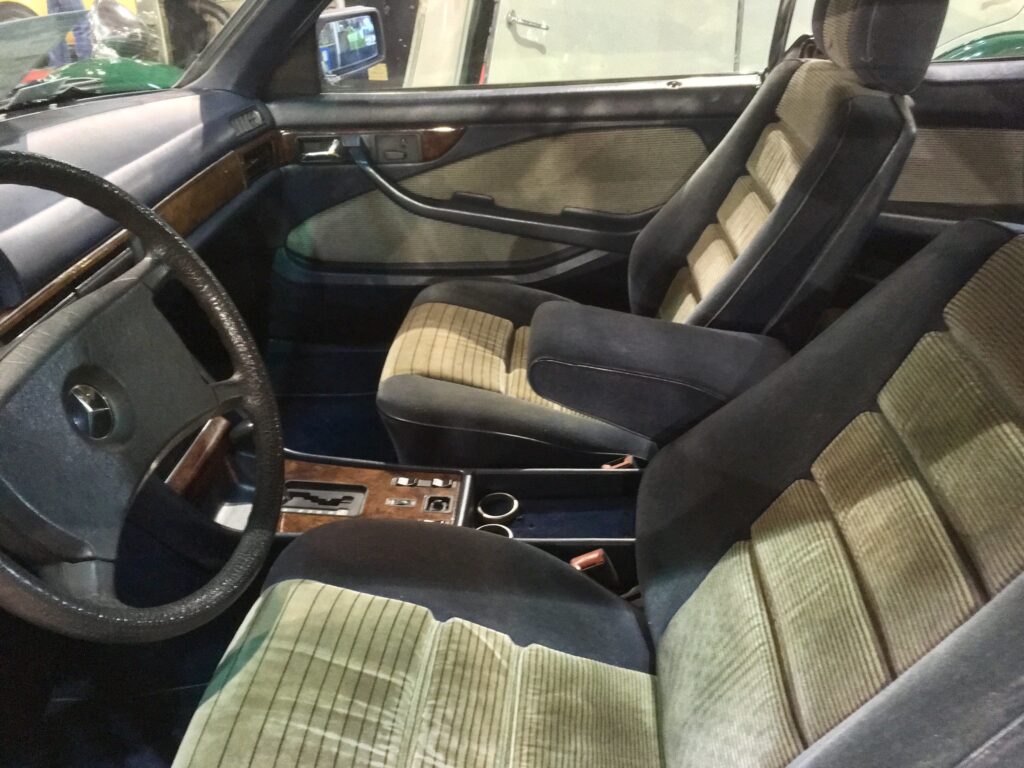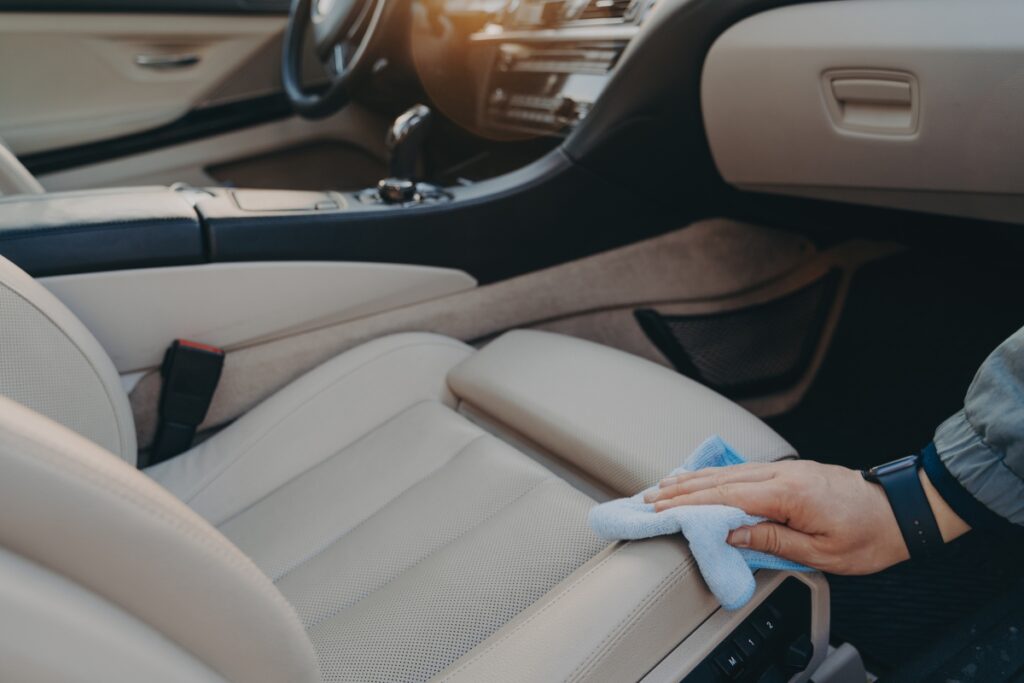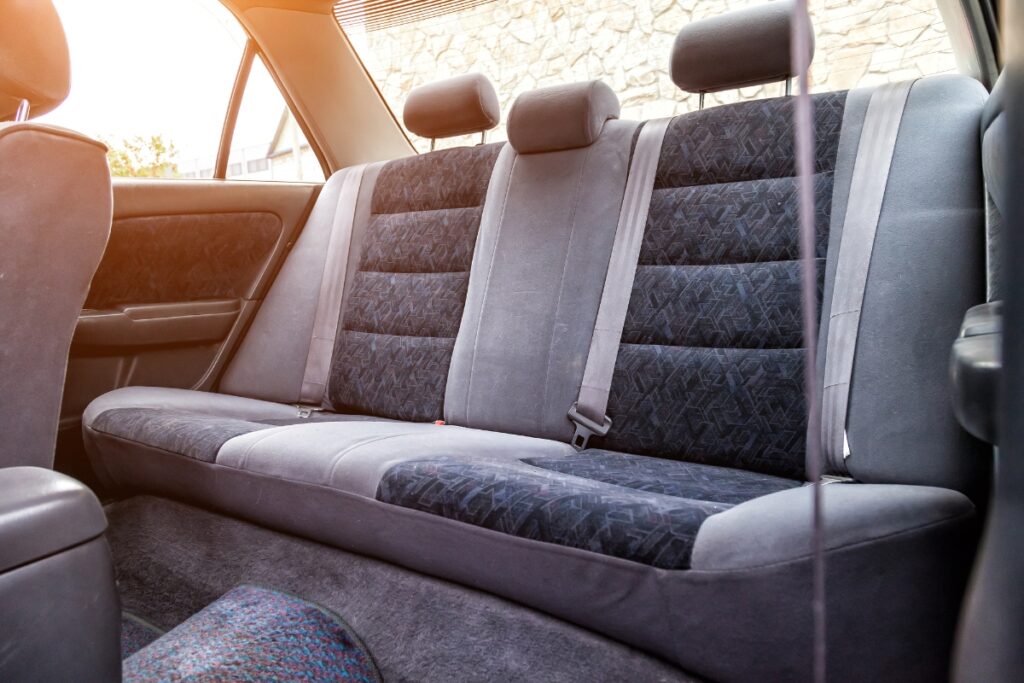
Why Deep Cleaning Fabric Car Seats Is Important :
Deep cleaning fabric car seats is crucial for several reasons:
- Health Benefits: Fabric Car Seats accumulate dirt, dust, and allergens over time, which can affect respiratory health. Consistent deep cleaning helps in eliminating these harmful particles, ensuring a healthier environment inside the vehicle.
- Aesthetic Appeal: Clean car seats enhance the overall appearance of the vehicle’s interior. Stains, spots, and grime can make the car look old and neglected. Regular cleaning restores the fabric to its original state, improving the car’s look.
- Longevity of Seats: Dirt and debris can wear down the fabric fibers, decreasing the lifespan of car seats. Maintaining a deep cleaning routine helps preserve the materials, making them last longer and reducing the need for early replacements.
- Odor Elimination: Spills, food particles, and sweat can lead to unpleasant odors in the car. Deep cleaning addresses these issues by thoroughly removing the substances causing the smell, leaving the interior fresh and inviting.
- Maintaining Resale Value: A well-maintained vehicle with clean Fabric Car Seats is more likely to retain a good resale value. Potential buyers often look for cars that have been well-cared for, and clean interiors can make a significant impression.
- Comfort: Fabric car seats can become sticky or uncomfortable when dirty. Regular deep cleaning ensures that the seats remain comfortable and pleasant to sit in during long drives.
Deep Cleaning Methods
- Vacuuming Regularly: Using a vacuum with attachments to reach crevices ensures the removal of loose dirt and dust.
- Shampooing: Applying fabric-safe shampoo and scrubbing with a soft brush helps to remove stains and deep-seated dirt.
- Steam Cleaning: This method uses high-temperature steam to disinfect and clean the fabric without the need for harsh chemicals, making it an eco-friendly option.
- Spot Cleaning: Immediate treatment of spills with suitable cleaners prevents permanent staining and reduces the spread of contaminants.
1 ) Tools and Products Needed
- Vacuum Cleaner with Attachments: Essential for removing loose dirt and debris.
- Fabric Cleaner: Choose a product that is safe for automotive fabrics.
- Soft Brushes: To avoid damaging the fabric while cleaning.
- Microfiber Cloths: These are effective in cleaning without leaving lint.
- Protective Gear: Gloves and masks can protect from allergens and chemicals used in cleaning.
Deep cleaning fabric car seats is not just about aesthetics but also about maintaining a healthy and comfortable riding environment. The process, although requiring effort, pays off by extending the life of the car seats and keeping the vehicle appealing both visually and functionally.
Gather Your Cleaning Supplies
Before beginning the process of cleaning fabric car seats, it is essential to gather all necessary supplies to ensure a thorough and efficient cleaning experience. Having everything at hand will help streamline the process and avoid unnecessary interruptions. Below is a definitive list of cleaning materials required:
Basic Cleaning Supplies
- Vacuum Cleaner
- A vacuum cleaner equipped with an upholstery attachment or a handheld vacuum is crucial for removing loose dirt and debris from car seats.
- Mild Fabric Car Seats Cleaner
- Use a specially formulated fabric cleaner suitable for car upholstery. Ensure it is compatible with the material of the car seats to avoid any damages.
- Soft-Bristle Brush
- A brush with soft bristles is necessary for gently scrubbing the fabric without causing abrasion or wear and tear.
- Microfiber Cloths/Towels
- Microfiber cloths are highly absorbent and non-abrasive, making them ideal for wiping away cleaning solutions and moisture.
- Spray Bottle
- Using a spray bottle will allow for even distribution of cleaning agents across the surface of the Fabric Car Seats.
Optional Cleaning Supplies
- Steamer
- A handheld steam cleaner can help in removing tough stains and sanitizing the fabric by using steam at high temperatures.
- Carpet and Upholstery Spot Cleaner
- Spot cleaners are handy for treating stubborn stains or for providing extra cleaning power to specific areas.
- Protective Gloves
- Wearing gloves protects the skin from potential allergens or irritants present in cleaning solutions.
Additional Supplies for Deep Cleaning
- Baking Soda
- Baking soda is effective for deodorizing fabric by neutralizing odors. It can be sprinkled on the seats and then vacuumed off.
- White Vinegar
- White vinegar serves as an excellent natural cleaner and can be mixed with water to remove moderate stains and odors.
- Leather Conditioner (if applicable)
- For vehicles with mixed fabric and leather interiors, conditioning the leather portions can maintain texture and appearance.
By having all the required materials, car seat cleaning becomes more manageable and effective. This preparation step ensures that the cleaner is equipped to tackle various types of dirt, stains, and odors for a comprehensive car seat cleaning process.
2) Vacuuming Your Car Seats Thoroughly
To ensure fabric car seats are properly cleaned, begin by vacuuming them thoroughly. This step helps remove loose dirt, dust, and debris from the Fabric Car Seats surfaces and crevices. Here’s a detailed approach to vacuuming car seats effectively:
- Gather Necessary Tools: Equip yourself with a high-powered vacuum cleaner featuring a hose and various attachments. A strong suction capability is essential to remove embedded particles. Consider using a vacuum with a HEPA filter to trap dust effectively.
- Prepare the Car Seats: Before vacuuming, remove any large debris or trash from the seats. Detach any removable parts, such asFabric Car Seats covers and headrests, if applicable. This helps in accessing all areas of the seat.
- Use the Upholstery Attachment: Begin with the upholstery attachment for broader surfaces. Glide it over the seats in a systematic pattern to cover all areas. Move horizontally and vertically to ensure thorough coverage.
- Tackle Crevices with a Crevice Tool: Switch to the crevice tool to clean tight spaces and seams. Use it along the edges, between seat cushions, and around seat belts. Pay special attention to areas where dirt tends to accumulate, such as the space between the seats and center console.
- Vacuum Under the Fabric Car Seats: Slide the front Fabric Car Seats forward and vacuum underneath to capture dirt that may be missed. Repeat the process with the back seats. Use the crevice tool to reach the corners effectively.
- Brush Stubborn Debris: For stubborn dirt or hair, use a soft-bristled brush attachment. Gently scrub the fabric to loosen particles before vacuuming them up. Avoid using hard bristles, which might damage the fabric.
- Repeat as Needed: For heavily soiled seats, you may need to repeat the vacuuming process multiple times. Ensure that the seats are free from visible dirt before moving on to the next cleaning steps.
Properly vacuuming car seats is a crucial first step in maintaining their cleanliness and prolonging their lifespan. By following these steps diligently, one can effectively prepare car seats for deeper cleaning methods that may follow.
3) Spot Treating Stains and Spills
When dealing with specific stains and spills on Fabric Car Seats, immediate action is crucial. Identify the type of stain first, as different stains require different treatments.
- General Stains:
- Blot the stain using a clean cloth to absorb as much liquid as possible.
- Apply a small amount of dish soap mixed with warm water.
- Gently scrub the area using a soft brush or clean cloth.
- Rinse with another cloth dampened with plain water.
- Blot dry with a clean microfiber towel.
- Grease and Oil Stains:
- Sprinkle baking soda or cornstarch directly on the stain.
- Let it sit for 10-15 minutes to absorb the oil.
- Vacuum the residue and apply a degreasing dish soap solution.
- Scrub gently and rinse with clean water.
- Dry by blotting with a clean towel.
- Coffee Stains:
- Blot up excess coffee using a clean cloth.
- Mix one part vinegar with two parts water.
- Dab the solution onto the stain and scrub gently.
- Rinse with water and blot dry.
- Ink Stains:
- Spray hairspray directly onto the ink stain.
- Blot the spot with a clean cloth.
- Repeat until the ink lifts from the Fabric Car Seats .
- Clean the area using a mild soap solution and rinse with water.
- Blood Stains:
- Use cold water to blot the stain; hot water can set the stain.
- Apply a small amount of hydrogen peroxide directly onto the blood stain.
- Blot with a clean cloth until the stain fades.
- Follow up with a mild soap solution to clean the area and rinse thoroughly.
Quotes for emphasis:
“Enzyme-based cleaners are effective for protein-based stains like blood and food spills.”
Handling odors:
- UtilizeFabric Car Seats fresheners designed for car interiors.
- Sprinkle baking soda on Fabric Car Seats , let sit for 15-20 minutes, then vacuum.
Precautions:
- Always test cleaning solutions on a hidden area of the seat fabric to ensure it does not cause discoloration.
- Avoid rubbing excessively as it can damage the fabric fibers.
By following these steps, Fabric Car Seats can maintain their appearance and cleanliness, ensuring a comfortable driving experience.
4) Homemade Cleaning Solutions vs. Commercial Products
When deciding between homemade cleaning solutions and commercial products for cleaning fabric car seats, both have their advantages and disadvantages. Understanding the differences can help in making an informed choice.
>Advantages of Homemade Cleaning Solutions
- Cost-Effective: Homemade solutions are typically made from ingredients already found at home, such as vinegar, baking soda, or dish soap, reducing the need to purchase special cleaners.
- Environmentally Friendly: These solutions often use natural, non-toxic substances, making them safer for the environment and reducing chemical exposure.
- Customizable: One can tweak homemade solutions to cater to specific needs, such as stronger stain removal or more gentle cleaning for delicate fabrics.
>Common Ingredients Used in Homemade Cleaners
- White Vinegar: Effective for removing odors and stains, vinegar is a versatile cleaner.
- Baking Soda: Known for its deodorizing properties, baking soda can also help with scrubbing away stains.
- Essential Oils: Adding a few drops can provide a pleasant scent to homemade cleaners.
>Disadvantages of Homemade Cleaning Solutions
- Effectiveness: Homemade solutions might not be as potent as commercial products, particularly for stubborn stains.
- Convenience: Preparing homemade solutions can be time-consuming compared to readily available commercial options.
- Limited Testing: These solutions may lack extensive testing for a wide array of Fabric Car Seats types, potentially leading to inconsistency in cleaning results.
>Advantages of Commercial Products :
- Efficiency: Commercial cleaners are specifically formulated to tackle a wide range of stains and dirt, often proving more effective.
- Convenience: Ready-to-use products save time, with no need for mixing or preparation.
- Fabric-Specific Formulas: Many commercial products are designed for specific fabric types, ensuring compatibility and better care.
>Disadvantages of Commercial Products
- Cost: These products can be more expensive than homemade alternatives.
- Chemical Content: Often containing strong chemicals, they can be harmful to the environment and potentially harsh on fabrics.
- Allergies and Sensitivities: Some commercial cleaners may cause allergic reactions or sensitivities due to their chemical ingredients.
For more tips and info check this out
Conclusion
Choosing between homemade cleaning solutions and commercial products depends on individual preferences, budget considerations, and specific cleaning needs. Balancing effectiveness, convenience, cost, and environmental impact will guide the decision in selecting the appropriate method for cleaning Fabric Car Seats
5) Deep Cleaning with a Steam Cleaner
Steam cleaning is an effective method to thoroughly clean fabric car seats. This technique uses high-temperature steam to loosen dirt, grime, and stains without the need for harsh chemicals.
>Step-by-Step Guide
- Vacuum the Seats:
- Prior to steam cleaning, vacuum the seats to remove loose dirt and debris.
- Pre-Treat Stains:
- For stubborn stains, pre-treat them with an appropriate fabric cleaner. Spray the cleaner on the stains and let it sit for a few minutes.
- Prepare the Steam Cleaner:
- Fill the steam cleaner’s water reservoir with distilled water. Avoid using tap water to prevent mineral buildup.
- Attach the appropriate upholstery cleaning attachment to the steam cleaner.
- Start Steam Cleaning:
- Turn on the steam cleaner and allow it to heat up to the required temperature.
- Test the steam on a small, inconspicuous area of the car seat to ensure it doesn’t damage the fabric.
- Clean the Seats:
- Hold the steam cleaner a few inches away from the fabric and move it in a slow, steady motion.
- Avoid soaking the fabric; use quick passes to prevent over-wetting.
- Wipe Off Moisture:
- As you steam clean, use a microfiber cloth to wipe off excess moisture and dirt lifted by the steam.
- This prevents water stains and speeds up the drying process.
- Dry the Seats:
- After steaming, allow the seats to air dry. Open the car windows and doors or use fans to enhance ventilation.
- Ensure the seats are thoroughly dry before sitting on them to avoid dampness and mold growth.
>Benefits of Steam Cleaning
- Effective Sanitization:
- The high-temperature steam kills bacteria, germs, and allergens, ensuring a germ-free environment.
- Eco-Friendly:
- Steam cleaning doesn’t rely on chemical cleaners, making it an environmentally friendly option.
- Versatile Cleaning:
- In addition to fabric seats, steam cleaners can be used for cleaning other car interiors like carpets and floor mats.
Essential Tips
- Regular Maintenance:
- Regularly steam cleaning car seats helps maintain their appearance and prolongs their lifespan.
- Avoid Over-Wetting:
- Be cautious not to over-wet the seats, as it can cause water stains and mold.
>Safety Precautions
- Test Fabric Car Seats Compatibility:
- Always test the steam cleaner on a small, hidden section of the seat to ensure it doesn’t damage the fabric.
- Protect Hands:
- Wear gloves to protect your hands from potential burns when handling the steam cleaner.
Using a steam cleaner for car seats is a powerful and eco-friendly way to maintain a clean, sanitized vehicle interior. This method not only removes dirt and stains but also helps in eliminating germs and allergens.
For more tips and tricks read out articles
6) Using a Carpet Cleaner for Fabric Seats
Using a carpet cleaner specifically designed for fabric seats can make the job easier and more effective. Here are the steps to follow:
- Choose the Right Cleaner:
- Select a carpet cleaner that is safe for use on fabric car seats.
- Reading the label on the cleaner to make sure it won’t harm the fabric.
- Vacuum the Seats Thoroughly:
- Begin by vacuuming the seats to remove any loose dirt and debris.
- Pay special attention to the crevices and seams where dirt tends to accumulate.
- Test the Cleaner:
- Test the cleaner on an inconspicuous area of the seat to ensure that it does not damage the fabric.
- Wait a few minutes to see if any discoloration or damage occurs.
- Apply the Cleaner:
- Use the applicator or spray bottle to evenly apply the carpet cleaner over the fabric.
- It is important to use enough cleaner to penetrate the fabric without over-saturating it.
- Scrub the Fabric:
- Use a soft brush or sponge to scrub the fabric gently.
- Work in a circular motion to lift the dirt and stains.
- Rinse the Fabric:
- Rinse the area with a damp cloth to remove any leftover cleaner.
- It is crucial to use clean water and ensure that all the cleaner is removed.
- Blot Excess Moisture:
- Take a dry towel and blot the fabric to remove any remaining moisture.
- Avoid rubbing the fabric as it can cause damage or spread the stain.
- Air-Dry:
- Allow the seats to air-dry completely.
- Open the car doors or windows to expedite the drying process.
- Final Vacuum:
- Once the seats are dry, give them a final vacuum to restore the fabric’s texture.
- This will also help to remove any remaining debris loosened by the cleaning process.
Tips and Precautions
- Avoid Direct Sunlight:
- Do not dry the seats in direct sunlight as it can fade or damage the fabric.
- Frequency:
- Clean fabric car seats every few months to maintain their appearance.
- Stain Removal:
- Address spills and stains immediately for best results.
- Professional Cleaning:
- Consider professional cleaning services for stubborn stains or periodic deep cleaning.
7) Drying the Seats Properly to Prevent Mold and Mildew
Properly drying fabric car seats is crucial to prevent mold and mildew growth. Several methods and steps can help ensure that the seats are dry after cleaning:
- Ventilation:
- Ensure the car is parked in a well-ventilated area.
- Open all windows and doors to promote airflow.
- If possible, place the car under a shaded yet breezy spot.
- Use of Absorptive Materials:
- Immediately after cleaning, use clean, dry towels to blot excess moisture from the seats.
- Apply pressure evenly over the entire surface to absorb as much water as possible.
- Utilizing Fans or Air Movers:
- Position fans strategically inside the car to blow air directly onto the wet seats.
- High-powered air movers or industrial fans can accelerate the drying process significantly.
- Dehumidifiers:
- Place a portable dehumidifier inside the car if available.
- Dehumidifiers help draw out moisture from the air, speeding up the drying of fabric seats.
- Heaters:
- Car heaters can also be used to aid the drying process.
- Set the car heater to a medium or high setting and direct airflow towards the seats.
- Exercise caution to avoid overheating the fabric and causing damage.
- Drying Agents:
- Silica gel packets or other drying agents can be placed inside the car.
- These materials absorb moisture and can be effective in smaller or enclosed environments.
Key Tips to Remember:
- Avoid direct sunlight for prolonged periods as it may cause the fabric to fade.
- Regularly check the progress by touching the fabric to ensure it is drying evenly.
- Rotate the fans or adjust their positioning to cover different areas thoroughly.
8) Potential Dangers of Inadequate Drying:
Neglecting to dry Fabric Car Seats properly can result in several issues:
- Mold and Mildew Growth: These not only cause unpleasant odors but can also pose health risks.
- Fabric Deterioration: Prolonged moisture can weaken fibers, leading to premature wear and tear.
- Unpleasant Smells: A damp interior leads to persistent, musty odors difficult to remove.
Ensuring seats are thoroughly dry will maintain the car’s interior quality, providing a clean, mold-free environment.
Regular Maintenance Tips to Keep Seats Clean
Maintaining fabric car seats involves adopting consistent cleaning habits and following a few essential tips to prolong their cleanliness:
- Vacuum Regularly:
- Vacuum seats at least once a week.
- Use a soft brush attachment to lift dirt without damaging the fabric.
- Pay special attention to seams and crevices where dirt tends to accumulate.
- Treat Spills Immediately:
- Blot spills with a microfiber cloth to absorb as much liquid as possible.
- Avoid rubbing, which can push the stain deeper into the fabric.
- Clean with a suitable fabric cleaner or a mild solution of water and detergent.
- Use Seat Covers:
- Consider using removable seat covers to protect the original upholstery.
- Choose covers that are machine washable for easy maintenance.
- Avoid Eating in the Car:
- Encourage passengers to refrain from eating in the car to minimize crumbs and spills.
- If eating is necessary, use a lap tray or similar to contain messes.
- Brush Seats Weekly:
- Use a soft-bristled brush to gently lift dirt and debris from the fabric.
- Brush in different directions to ensure thorough cleaning.
- Protect from Sunlight:
- Utilize sunshades or park in shaded areas to prevent UV damage and fading.
- Apply a fabric protectant that includes UV inhibitors for additional protection.
- Use a Fabric Car Seats Freshener:
- Apply a fabric freshener to neutralize odors and keep seats smelling fresh.
- Ensure the freshener is compatible with car upholstery to avoid damage.
- Implement a No-Shoes Policy:
- Encourage passengers to avoid placing dirty shoes on the seats.
- Provide a designated area for shoes if necessary.
- Professional Cleaning:
- Schedule a professional car seat cleaning once or twice a year.
- Professionals use dedicated equipment and solutions that offer a deep clean.
Keeping car seats clean requires regular attention and habits that prevent dirt and stains from becoming ingrained. Following these tips can ensure fabric seats remain in a well-maintained and pristine condition.
9) Extend the Life of Your Fabric Car Seats
Maintaining clean fabric car seats not only imroves the overall appearance of the vehicle’s interior but also greatly extends the life of the fabric. Regular cleaning and proper care can prevent stains from setting in and protect the seats from wear and tear.
Here are some essential tips to keep fabric car seats in optimal condition:
- Routine Vacuuming
- Vacuum the seats weekly to remove dirt and debris.
- Pay special attention to crevices and seams where dirt can accumulate.
- Spot Cleaning
- Address spills and stains immediately with a suitable fabric cleaner.
- Blot rather than rub to avoid spreading the stain.
- Use Protective Covers
- Consider using seat covers to shield the fabric from spills, stains, and daily wear.
- Covers are easy to remove and wash, helping keep the original fabric pristine.
- Regular Deep Cleaning
- Perform a deep cleaning every few months using an upholstery cleaner.
- Follow the instructions carefully to avoid damaging the fabric.
- Sun Protection
- Use sunshades or park in shaded areas to protect against UV damage.
- UV rays can cause fabric to fade and degrade over time.
- Avoid Harsh Chemicals
- Refrain from using bleach or strong chemicals that could harm the fabric.
- Opt for gentle, fabric-specific cleaning solutions.
- Conditioning Fabric
- Use a fabric conditioner to maintain softness and prevent the fabric from becoming brittle.
- Conditioning can also add a layer of protection against spills and stains.
By following these steps, vehicle owners can ensure their fabric seats remain clean, comfortable, and durable. Consistent care not only enhances the vehicle’s appearance but also preserves its value, contributing to a prolonged lifespan for the car seats. Whether through routine vacuuming, spot cleaning, or protecting against UV damage, each measure plays a critical role in maintaining the integrity and appearance of the fabric car seats.




